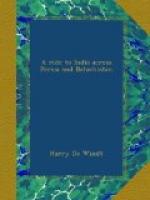The Wazir sent me a bag of dates the morning of my departure, with a short note, written in English, begging that I would send him in return the best gold watch and rifle “that could be bought for gold” in London. The note ended jocosely, “Exchange is no robbery!” The old man seemed well au fait with Central Asian affairs. On my mentioning the day before that I had intended entering India via Cabul, he at once said, “Ah! I supposed Alikhanoff stopped you. He is very shy of strangers.”
We left Kelat at 6 a.m. on the 12th of April. The camels and heavy baggage had been sent on four or five hours previously to Mangachar, the first station. Our caravan now consisted of only eight camels, which we found reduced to seven on arrival. Just before daylight a couple of panthers had appeared close to the caravan and caused a regular stampede, the beasts flying right and left. On order being restored, two were found to be missing, one laden with the only small remaining tent and some native luggage, the other with a couple of cases of whisky (nearly empty) and my camp-stool. The former was traced and brought in after a search of over two hours, but the latter is still, for aught I know, careering over the boundless desert, an unconscious advertiser of “Jameson and Co.” I afterwards heard that this plain is noted for panther and wolf, also an animal called the “peshkori,” somewhat larger than a cat, with a reddish-coloured hide. It moves about the country in packs, carrying off deer and sheep. Its method of descending precipices and steep hillsides is curious, each animal fixing its teeth in the tail of another, thus forming a kind of chain.
The plain of Mangachar is situated nearly 6000 feet above sea-level, and is well cultivated with wheat, lucerne, and tobacco. The village itself is neatly laid out, and contains about three hundred inhabitants. The different aspects of the country north and south of Kelat are striking. We had now done with deserts for good, for at night lights were seen twinkling all over the plain, while in the daytime large tracts of well-cultivated land continually met the eye.
Between Mangachar and Mastung a hot wind arose, which made the eyes smart, and dried up the skin like a blast from a furnace. One’s hair felt as it does in the hottest room of a Turkish bath, with the unpleasant addition of being filled with fine gritty sand. “I hope this may not end in a juloh,” said Kamoo, anxiously. This, my interpreter proceeded to explain, is a hot poisonous wind peculiar to these districts, and perhaps the greatest danger run by travellers in Baluchistan. The warm breeze, as Kamoo called it, that we experienced was, though almost unbearable, not dangerous, while the dreaded juloh has slain its hundreds of victims. Cook, the traveller, who has given this subject much attention, has come to the conclusion that it is caused by the generation in the atmosphere of a highly concentrated form of ozone, by some intensely marked electrical condition. As evidence of its effect in destroying every green thing on its course, and in being frequently fatal to human life, he cites the following well-authenticated cases, which, not having encountered the death-dealing blast myself, I place before the reader:—




